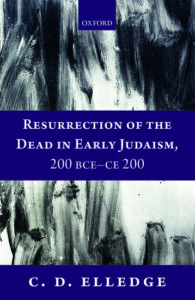
This past summer, Dr. Casey Elledge published Resurrection of the Dead in Early Judaism, 200 BCE – CE 200. Appearing with Oxford University Press, the book offers an interpretation of some of the earliest literature within Judaism that exhibits a confident hope in resurrection. The book not only aids in the study of early Jewish literature itself, but expands our knowledge of some of the earliest expressions of a hope that would become increasingly meaningful in later Judaism, Christianity, and Islam.
As Dr. Elledge writes: “This is a book I always wanted to write, because I am really fascinated by the topic. Resurrection is a premier instance of how the emergence of Christian theology was forever shaped by its early Jewish context. The book explores the varied forms and meanings that resurrection held in ancient Judaism prior to era of Christian origins. The topic also brings together much of the literature that I am most interested in: Dead Sea Scrolls, Apocrypha, Pseudepigrapha, Philo of Alexandria, and Josephus.”
The book also incorporates later rabbinic writings, early Christian sources, and inscriptions, as they shed additional light upon select features of the evidence in question. This allows for a deeper look into how particular literary works utilized the discourse of resurrection, while also retaining larger comparative insights into what these materials may teach us about the gradual flourishing of resurrection within its early Jewish environment.
Dr. Elledge continues: “One of the more interesting facets of this research for me was appreciating more deeply how beliefs about the afterlife became points of controversy in this era. Such controversies often extended beyond the question of death: beliefs about divine justice, the shape of creation, human embodiment, and how to interpret earlier scriptures were also often at stake in the interpretation of death. It is fascinating to observe the variety of ways in which resurrection was envisioned in this context. Hopefully, that variety will allow people today to expand their own religious imagination when discussing the topic.”
(Visitors to the Department can read a copy of the book, which is on display in the third floor “Faculty Publications” bookcase.)